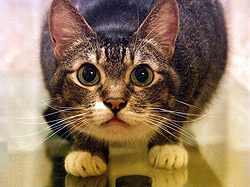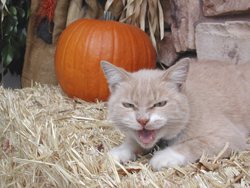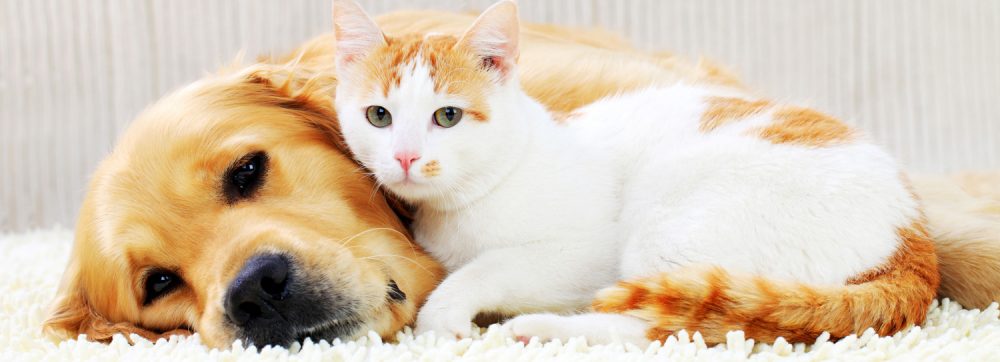The adult cat flea (Ctenocephalides felis) is a ubiquitous, enterprising and persevering insect. The cat flea is the most dominant, competitive and most common flea associated with domesticated animals today.
It has been linked to numerous human diseases (such as the plague or typhus) and re
 mains the scourge of veterinary medicine.
mains the scourge of veterinary medicine.
Cat fleas are known to infest numerous hosts, including the domesticated cat, dog, ferret and many other wild animals. They have been identified in large numbers on raccoons, opossum, skunks, domesticated rabbits, coyotes, foxes, mongooses (in parts of Hawaii) and even koalas. They are known to infest cows, goats and certain types of poultry.
Busting rumors
Unfortunately, most owners, pet-store personnel and groomers tend to perpetuate numerous false facts about the hosts of the adult cat flea. It is rarely, if at all, found on squirrels and wild rabbits. The belief that squirrels are promoting and infecting the environment is a common misconception, especially among pet owners. The real culprits are nocturnal animals such as opossum, raccoons, feral cats and skunks frequenting pet owners’ backyards and gardens. This environmental contamination can lead to adult flea infestations on pet animals, and subsequent problems in homes.
This leads to another of the common misconceptions about fleas: They jump from one infested pet to another. What is fascinating and amazing is that many veterinarians believe this myth.
The adult cat flea is very much happy and content to live on a cat or dog. The adult flea has everything it needs. They have a warm place to live, a place to hide from predators and a constant source of nutritious food (blood meal of the host).
Typically, fleas do not leap from host to host as a rule. This phenomenon has been observed when there is a severe overpopulation of adult fleas on a pet.
Hitching a ride
The problem begins when these adult fleas begin to breed (especially in flea-allergic pets). Adult fleas feed on the host within a few minutes or less after establishing a safe home. Breeding begins (usually within a day or two after feeding) followed by egg production. On any given host there are about twice as many adult female fleas as males. These female fleas are capable of laying up to 40 to 50 eggs per day.
Most eggs desiccate in the outdoor environment after dropping off the host. Most experts believe that 50 percent to 70 percent or more of the ova produced by a female flea may be viable. It appears that the outdoor environment is much harsher than indoor environments. Lack of humidity (50 percent or less) is second to lack of a food source as the most lethal environmental condition immature fleas are exposed to. Egg production and hatching eggs begin within 48 hours. Eggs are not sticky, and fall to the ground. As mentioned previously, ova do not survive without adequate moisture (humidity). Surviving eggs will begin to hatch into larvae. Larval survival is dependent upon adequate moisture as well. Thus, desiccation of larvae can occur. Larvae will survive in soil, grass, carpets, unwashable pet bedding, as well as within cracks between hardwood floors. Larvae may drown in soil that is over saturated. The main food source for these larval organisms is the adult-flea feces that deposits in the environment where the animal may frequent. Egg survivability and larval development is dependent upon temperature. The ideal temperature is 65F-75F degrees (with relative humidity around 75 percent). Keep in mind that humidity is much higher deep in the carpet pile or soil, compared to the humidity measured in the air.
It is important to point out the amazing survivability of fleas and the immature stages. All stages of the flea life cycle can survive temperatures as low as 28F (for brief periods of time) and as high as 95F. Most immature stages do not survive above 95F, especially in full sun.
In colder climates, like the Northeast, fleas may continue to survive living on hosts in pets or wild-animal bedding, in carpets, in freeze-protected areas around homes or in wild-animal burrows.
The surviving larvae feed voraciously on adult-flea excrement and undergo at least two moltings over a course of one to two weeks. This pre-pupal stage may be the most critical stage in regard to environmental control, which will be discussed later. Mature larvae will actually transform into a cocoon or pupae. The cocoon is literally spun with “silk” by the mature larvae. The cocoon is covered in this silk (that is sticky) produced by the larvae but soon becomes covered in environmental debris, such as soil and other loose particles.
The pupal stage is the most indestructible to environmental hazards as well as insecticides. Pupae make up about 20 percent of the total life cycle but survival can be as high as 80-90 percent, obviously much higher than eggs and larvae.
Approximately one week after the formation of the pupal stage, the newly emerged adult is ready to leap onto the host. If environmental conditions are poor (i.e., very cold temperatures or low humidity), there may be a very long delay in the emergence of adults.
This delayed emergence is a very important detail in the flea’s life cycle. Its ability to rest and emerge at a much later date often can surprise the owner and the veterinarian. It has been proven that this delayed emergence can be up to seven to eight months.
The triggers that allow the cocoon to hatch and promote the emergence of the adult include exhaled carbon dioxide from host. In addition, body heat is considered to be a trigger that promotes pupal hatching.
Lastly, another trigger for hatching is vibration. As the host walks along, certain vibrations, such as debris moving about, promote the emergence of the adult flea.
Understanding the life cycle of the flea can allow the clinician to make reasonable decisions and offer proper treatment options. This is especially true for cases of flea-allergy dermatitis (FAD).
Clinical distribution
Canine FAD is a common disease, is often overlooked, and can range in severity. The clinical distribution can vary, but usually it is fairly consistent in dogs and is mainly confined to the dorsal lumbar-sacral area and groin. It is characterized by alopecia, erythema, excoriations and occasional concurrent pyoderma. Pruritus can be severe and result in substantial hair loss, hot spots (pyotraumatic), and secondary (often recurrent) superficial pyoderma on the groin. Less common, mild pruritus on the rump may be accompanied by more substantial, severe recurrent pyoderma of the groin.
Flea allergy in the cat can be a more challenging diagnosis. Cats are very efficient groomers and often swallow fleas, making it very hard to convince the clinician (as well as the owner) that fleas are the cause of the pruritus. The clinical presentation can be similar to dogs. Alopecia (caused by “over-grooming”) can be present on the rump and/or groin without obvious inflammation. Cats rarely develop pyoderma. Some cats present with military dermatitis around the neck, and it is characterized by numerous small-crusted papules with concurrent pruritus in the same area.
Adult fleas may be seen, but are not necessary to make a tentative diagnosis of FAD. Unfortunately, atopic dermatitis uncommonly accompanies FAD and can often confuse or distract the clinician.
In general, I recommend a good quality monthly product such as the topical spot-ons Advantage, Frontline, Vectra 3-D, Promeris or Revolution, or the monthly oral flea product Comfortis. These products have some differences, but in general they all work adequately for flea control. One limitation that I have noticed with some of these products is it appears they “wear off” in about two to three weeks after application. However,I have been recently impressed with the duration of action with Vectra 3-D and Comfortis. Since some of these products may “wear off” in about two to three weeks, active adult fleas may be noticed just before the next dosage. This is not due to resistance, but to the limitations inherent to these products. Sometimes, frequent swimming or bathing (especially with harsh shampoos) can remove some of these products as well. Capstar is recommended and can be used in acute infestations for a rapid onset in flea control. It can be used as a long-term maintenance regimen every other day or every third day.
Lastly, in situations where the environment has numerous hatching pupae topical spot-on products may be overwhelmed. In treatment failures, I recommend increasing the monthly topical products to every two to three weeks. Sometimes we may add additional treatments including Capstar. This product has a very wide safety margin and can be used in puppies and kittens as young as 4 weeks old. Capstar is quite effective, but may only last one to two days after administration.
The environmental infestation with pre-adults is often the most overlooked portion of flea control. As mentioned previously, about 70 percent to 80 percent or more of the life cycle is hidden in the environment. The eggs, larvae and pupae are in the soil, grass, gardens and the home. In California and the arid West, immature stages perish in non-irrigated areas by mid-summer. However, they survive quite nicely in indoor environments such as carpeting, area rugs, pet bedding, cracks between hardwood floors, upholstered furniture (under cushions), and in carpeted hallways in common areas in apartments.
Since the pupal stages are virtually indestructible, they may continue to emerge over time (delayed emergence) and jump on pets even though proper adulticides are being used and the environment has been treated with insect growth regulators (IGRs such as methoprene or pyriproxifen). These IGRs are very helpful and will target and kill most of the larval and some of the egg stages, but not the coccoon stage. Stopping egg hatchability and interfering with larval molting blocks a big portion of the pre-adult life cycles.
In moderate to severe flea infestations or with “treatment failures,” I recommend spraying the indoor environments with products that contain these IGRs. Knockout or Siphotrol brands are adequate. I prefer Knockout spray, because it tends to dry on contact and is less messy. These sprays are designed for indoor use only. They contain permethrins that may have ovicidal activity but mainly kill newly emerging fleas from cocoon stages for a quick “knock down” of adults. Sodium polyborate (Fleabusters) is effective in the home, and “dehydrates” larvae by desiccation. It is speculated that the larvae choke on the fine dust.
The outdoor environment can be treated with larvicidal sprays. I do not recommend malathion or diazinon because these chemicals are environmentally unsafe to other beneficial insects and wildlife. What we do recommend is a biological product that contains nematodes (Steinernema). These nematodes are natural and preferentially feed on parasitic larvae (fleas, cutworms, Japanese Beetles, etc.) and work quite well. They need some moisture periodically and may need to be replenished every few months.
In summary, with the arrival of the newer generation insecticides, the ability to apply the “monthly” spot-ons every two to three weeks, and the knowledge of the flea life cycle, clinicians should be able to better manage those difficult cases of flea-allergy dermatitis.
Dr. Vitale received his veterinary degree from Mississippi State University, College of Veterinary Medicine. He completed a residency in veterinary dermatology at the University of California, Davis and is a diplomate of the American College of Veterinary Dermatology. He is a clinical instructor/lecturer at UC-Davis and a staff dermatologist at East Bay Veterinary Specialists (formerly Encina Veterinary Hospital), Bay Area Veterinary Specialists and San Francisco Veterinary Specialists.



 mains the scourge of veterinary medicine.
mains the scourge of veterinary medicine.